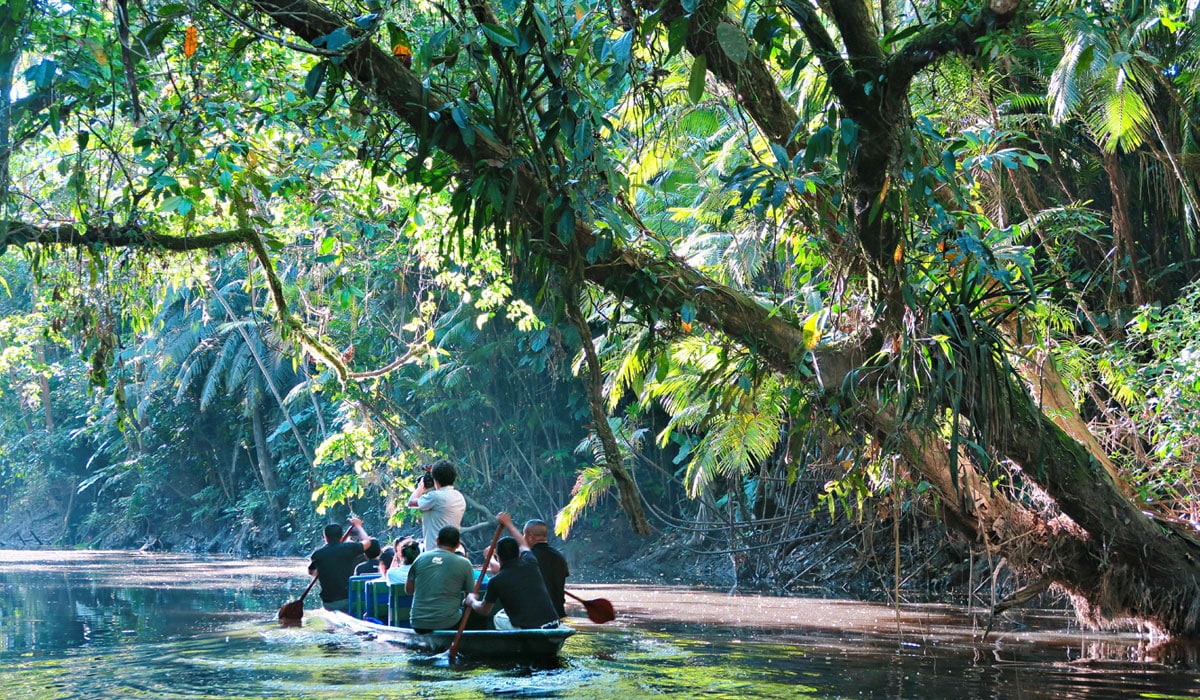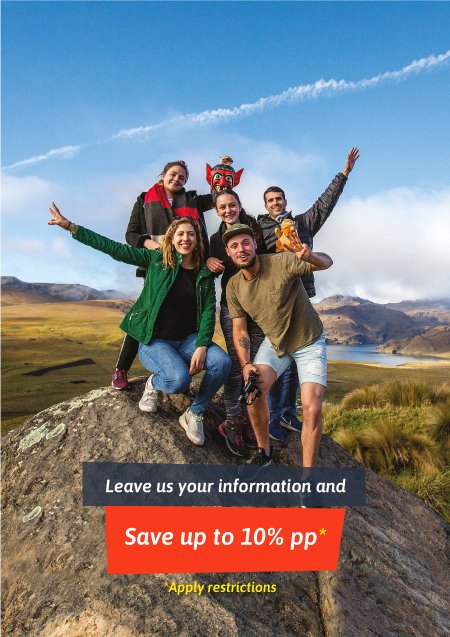
As the “Gateway to the Amazon”, Baños is your ideal Ecuadorian destination. It offers travelers innumerable adrenaline-fueled activities, delicious food, and incredible views – not to mention a glimpse into the rainforest when you travel beyond the western edge of town. For those of you who want more than a glimpse, here’s how to get to Ecuador’s Amazon jungle from Baños.
Traveling from Baños to the Amazon Jungle: What to Consider
As you plan your trip to the Amazon from Baños, consider the following factors: how long, how much, and when.
How long? — Plan to spend at least two nights in the Amazon, depending on what area you’re visiting. If you’re planning to travel deep into the Amazon, for instance, to Yasuní National Park, expect to stay at least four nights.
Are you a backpacker, or do you prefer maintaining your daily comforts? In the Ecuadorian Amazon, there isn’t much of an in-between category, and costs vary significantly.
How much? — As a backpacker, expect to take cheap but sometimes inconvenient and uncomfortable public transport to your destination and embrace a “go-with-the-flow” attitude. As a more comfort-focused traveler, you might need to book your trip in advance online or in Baños or Puyo to ensure everything goes as planned. Chances are the costs will be a little higher.
When? — The Amazon consists of two seasons: wet and dry. Depending on what you want to see and experience, choose your timing wisely. Read the section below, “Best Time to Travel to the Amazon Jungle,” for specifics.
How to Travel from Baños to Ecuador’s Amazon Jungle and a Few Places You Can’t Miss
The cheap and simple way to get to the Amazon from Baños is by bus. Buses depart regularly from the Baños Bus Terminal (Terminal Terrestre Baños, in Spanish) to the jungle city of Puyo or the towns along the way like Mera.
Just one hour down the road from Baños, Mera is a small town, home to fewer than 1000 inhabitants. If you stop there, make sure to visit its breathtaking lookout point, El Mirador de Mera.
From Puyo, you can arrange day-trip tours and activities like visits to nearby indigenous community-led tourism initiatives only 30–45 minutes away by road. Among these are the Indichuris lookout point (Mirador de Indichuris) and Hola Vida Waterfall (Cascada Hola Vida), both belong to the Kichwa indigenous communities of the surrounding area.
If you’re hoping to buy locally-produced souvenirs, check out Omere Texturas de la Selva, located between Baños and Puyo, where you can buy intricate, hand-made products from the Waorani indigenous tribe.
What You Need to Know Before Booking a Tour to the Amazon Jungle
There are three general approaches to planning your trip to the Amazon from Baños. They are:
Book in Advance — Do some online research at home and book all-inclusive tour packages before arriving in Ecuador. The advantage to this approach is that you’re worry-free upon landing, but the downside is that it comes at a relatively high price.
Book from Baños — Opt for a local tour agency in Baños with set itineraries and packages from which to choose. The advantage of this approach is that you might find more competitive prices. Still, you’ll have to make your way to Baños on your own. Also, there may be limited availability for any number of reasons like high- or low-season (in terms of tourism) and weather.
Go With the Flow — From Baños, continue down the lush, forested slopes towards the Amazon and see what happens. You’ll definitely find more affordable options this way, but this approach is also less time-efficient.
What to Pack Before Traveling
As you plan your trip to the Amazon, there are two main things you want to avoid: getting wet and insect bites.
The trouble with getting wet in the Amazon is that, since the climate is quite humid, your clothes and socks may never dry, so just keep that in mind as you pack.
Make sure you have rain protection like a poncho or light raincoat (water-resistant clothing isn’t good enough).
- If you’re planning to hike, take a pair of rubber boots (you can buy some in Baños) or make sure the tour or lodge provides these.
- Take a few extra pairs of socks (these are especially nice to use with rubber boots to avoid getting blisters).
- Pack a couple of Tek Towels™ (or equivalent) and some quick-dry shirts.
- Pack a light sweater, as it can feel chilly after a wet afternoon.
Avoiding Insect Bites and Stings:
- Make sure you buy insect repellent in Baños.
- Pack a breathable long-sleeve shirt and pair of pants.
- If you’re planning to venture deeper into the rainforest, make sure the hotel, lodge, or community you’re visiting provides mosquito nets.
- Are you allergic to bites or stings? Pack an over-the-counter antihistamine like Benedryl or Claritin. And if you are allergic to stings, make sure to pack your Epi-Pen (injectable epinephrine).
- Avoid going to the Amazon during the warmer, wetter months when there are more mosquitos.
- Avoid sandy river banks where sand fleas abound. Sand fleas don’t respond to mosquito repellent. Instead, try rubbing a skin-safe oil on your skin, impeding the fleas’ movement on your skin.
Other items you should pack for your trip to the Amazon region include:
- An extra set of clothes
- Sun protection in the form of sunscreen, a hat, sunglasses, and light, long-sleeve shirts
- Flip-flops (you’ll want to allow your feet to breathe while protecting them from the ground and its inhabitants)
- Snacks
- A headlamp
- Reusable water bottle (make sure you have access to potable water on your trip or else consider taking a portable camping-style water filter)
- Camera or phone and something to protect it from moisture
- Binoculars, especially if you want to take part in bird-watching activities.
Best Time to Travel to the Amazon Jungle
There are two seasons in the Amazon: wet and dry. Wet season typically extends from March through June and then again around November and December. Dry season tends to take place from December through February and July through October.
If you hope to explore the Amazon by boat, the rivers are more easily navigated during the wet season. Depending on the region you visit, you can expect to see more caimans, anacondas, primates, and birds during the wet season, not to mention mosquitos.
If you prefer exploring on foot, with fewer mosquitos and less rain, you might want to visit during the dry season, but expect warmer weather, about 86°F – 95°F (30ºC – 35ºC), during the day. You might see more animals along the water’s edge, but the heat forces many of them, especially birds, to retreat deeper into the forest.
High-season for tourists tends to occur between June and September, as well as December and January; so, you may find higher prices and less availability during these months.


